Wonderful World of Woodpeckers!
Everyone enjoys watching a woodpecker work (unless you’re a grub, a tree, or the owner of a wooden house!). But why does a woodpecker peck wood? Here are some fun facts about woodpeckers—including how to identify a few common types of woodpeckers—with beautiful photos of these magnificant birds.
Why Woodpeckers Peck at Trees
Most folks probably assume that woodpeckers peck at trees for food, which is true. These birds feed on tree-living or wood-boring insects, including larvae or ants from burrows within the wood. However, they also drill to build nests and they will “drum” at trees to announce their territory. This sounds like pecking in rapid succession and is done a number of times in a single day—and it can last for weeks or months!
How Woodpeckers Avoid Concussions
When woodpeckers are drilling for food, it’s forceful! They get hit with up to 1,400 g’s of force—14 times the amount that would trigger a concussion in humans. However, woodpeckers are particularly well-adapted for drilling on and into trees without getting a concussion. They have thick skulls with an enlarged brain case designed to absorb a frontal impact. Additionally, the lower part of the beak is longer, so when it strikes wood, the force is transferred through the lower jaw rather than through the skull. They hammer directly into the wood so that the force is evenly distributed.
The bill is a carpenter’s tool, but the tongue, which is long, barbed and sticky, obtains the food: usually larvae of carpenter ants and other insects. A woodpecker can stick its tongue through small tunnels in the wood. Because a woodpecker’s tongue is so long, it wraps around the skull and through the bill when it’s not being actively used. Muscles contract and relax as the tongue is extended to grab larvae and then retracted.
Woodpecker Nesting Habits
As you might expect, woodpeckers nest in holes that they’ve bored about 5 to 50 feet up a dead or living tree. They excavate a round hole 8 to 16 inches deep in a gourd shape; there’s no lining except for a few wood chips and they lay 4 to 5 white eggs, which hatch in 16 days. Young remain in the nest about 20 days before fledging.
Common Woodpecker Species
Downy and Hairy Woodpeckers
The most likely woodpecker to visit your backyard bird feeder, the Downy Woodpecker (Picoides pubescens) is the smallest of North American Woodpeckers, about 6 to 7 inches long and barely outsizing chickadees and nuthatches. It can be found year-round throughout the continental United States and southern Canada. Audubon said, “it seems, in fact, to accommodate itself to circumstances, and to live contented anywhere”.
Males have a bright red patch on the back of the head, while females have a black patch, but otherwise the two look very similar. Males prefer to forage on smaller branches, while females prefer larger branches and the tree trunk. Woodpeckers like to drum on trees, preferably dead trees, and metal boxes on communication poles, usually in spring when attracting mates.
To the casual observer, the Hairy Woodpecker (Picoides villosus) looks almost identical to the Downy Woodpecker, but is slightly larger with larger bills. Scientists have determined that the smaller Downy Woodpecker has evolved to match the larger Hairy Woodpecker because it confers an advantage by being confused with the larger species.
Both Downy and Hairy Woodpeckers can be attracted to feeders with black oil sunflower seeds, but especially love suet! (See how to make suet.)
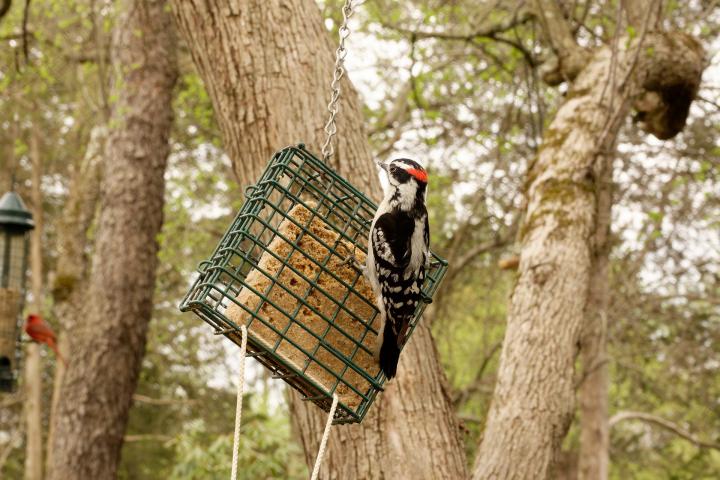
Image: Downy Woodpeckers and Hairy Woodpeckers love suet!
Yellow-Bellied Woodpeckers
Often called the “Yellow-Bellied Sapsucker,” (Sphyrapicus varius) this medium-sized woodpecker is named for its habit of pecking rows of holes in trees, especially apple trees, and then drinking the sap and eating insects in the sap. The bird will breed in Canada and in the Northeastern U.S. but in winter months it migrates farther south; it’s the only woodpecker in eastern North America that is completely migratory.
Though the Yellow-Bellied Sapsucker isn’t usually a bird feeder visitor, you’ll be able to identify its work by the rows of shallow holes in tree bark, especially the bark of young maples or birch trees. They’ll often sit still on tree trunks for long intervals.
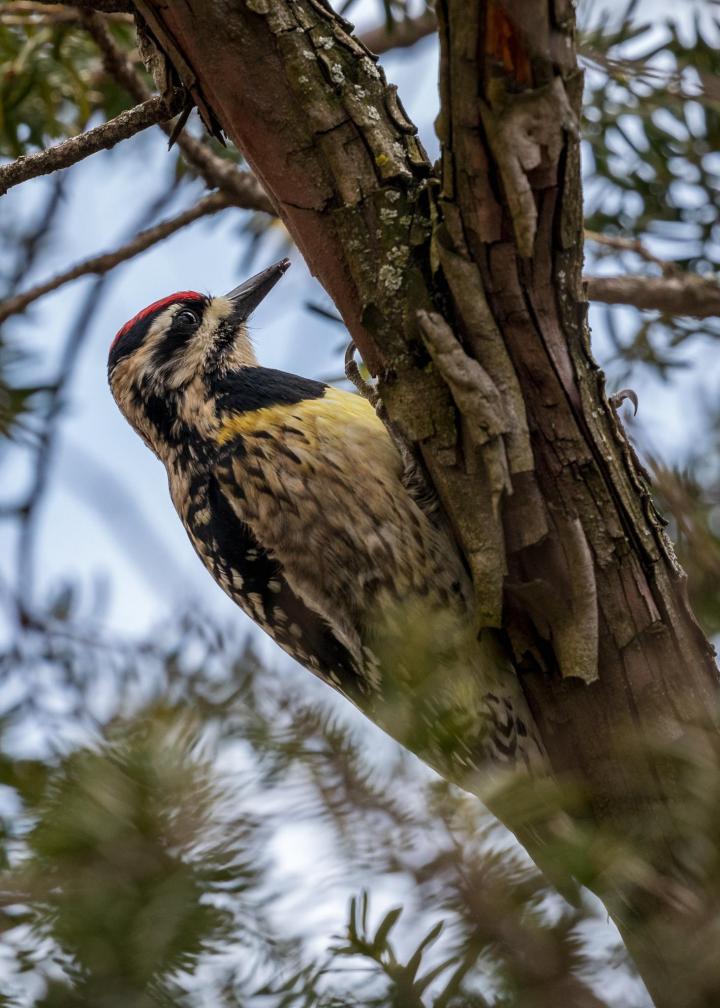
Image: Yellow-belled Sapsucker hard at work.
Red-Bellied Woodpeckers
Poorly named (because the reddish-orange color is found mostly on the head), the medium-size Red-Bellied Woodpecker (Melanerpes carolinus) was once a more southern bird. With climate change, it has moved a little more northern and its range covers the wooded patches from the Midwest across to the Eastern coasts.
With it red crown, this bird looks similar to the Red-Headed Woodpecker (below), but it has a paler tummy and does not have black on its back.
Red-bellied woodpeckers are also more common, and more easily found at bird feeders because the species eats a varieties of seeds and nuts and also likes suet!
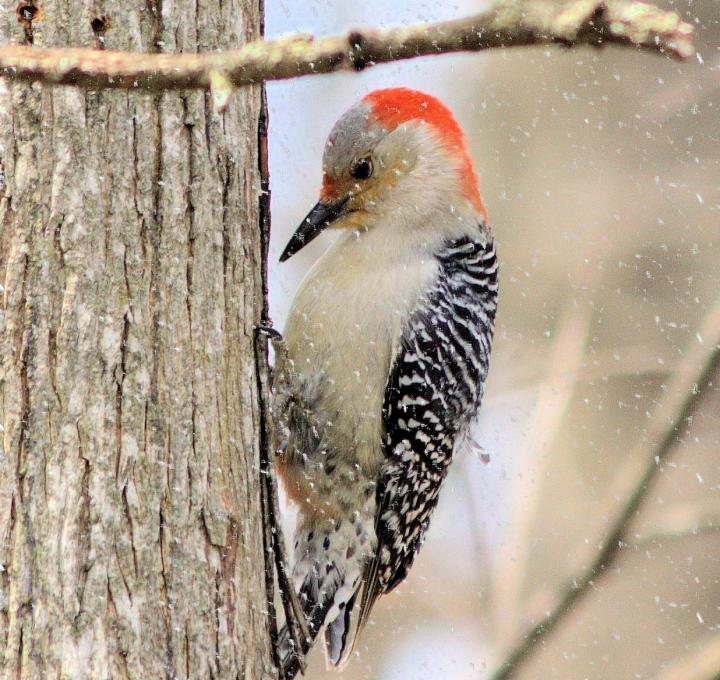
Image: Red-bellied Woodpeckers are one of the most common woodpeckers you’ll see at bird feeders!
Red-Headed Woodpeckers
Easily identified with its distinct crimson head and a snow-white body, the Red-Headed Woodpecker (Melanerpes erythrocephalus) has gone through periods of great numbers and near extinction due to habitat loss. They live year-round throughout the central and Eastern U.S. from Florida up through Canada.
What’s unusual about the Red-Headed Woodpecker is that it catches insect in the air and also enjoys eating nuts. They’ll occasionally visit bird feeders, especially suet feeders.
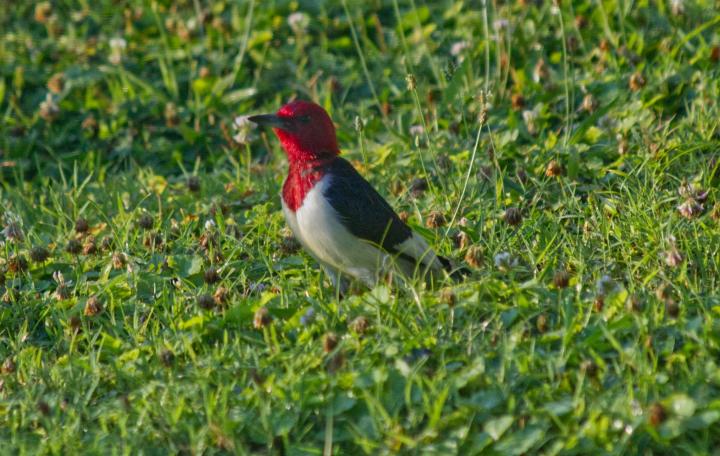
Image: Notice how the crimson color not only covers the head but also the throat of the Red-Headed Woodpecker.
Pileated Woodpeckers
A large, striking, crow-sized bird, the Pileated Woodpecker (Dryocopus pileatus) is the largest woodpecker in North America, reaching up to 18 inches in length. Its population has increased over the past 50 years as many farms have become forested land in much of the United States.
Its sight and hearing are excellent, so it is not seen as often as heard as it whacks at dead trees and fallen logs searching for prey, making wood holes as large as 14 inches in larger trees such as spruce and hemlock. Also listen for this bird’s amazing call. Hear the sound of the Pileated Woodpecker.
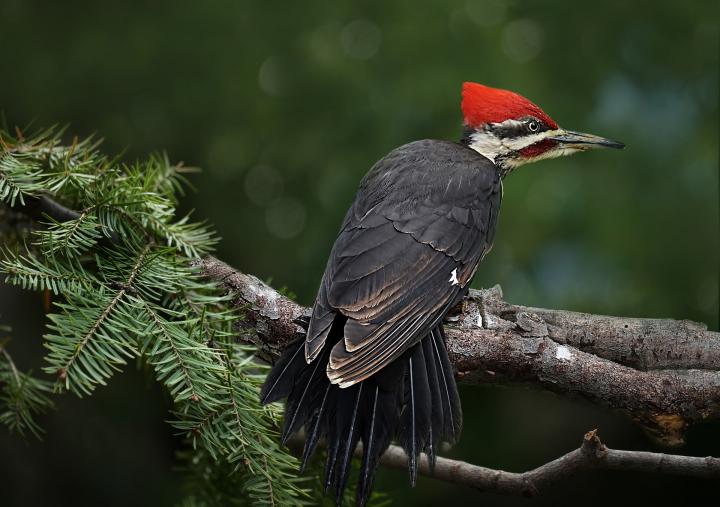
Image: If you have dead or dying trees, leave them for the Pileated Woodpeckers!
Woodpeckers love suet! See our recipe for Woodpecker Pudding—a suet–peanut butter concoction that will drive all the wild birds, well, wild!
Enjoy birdwatching? See more backyard bird articles.
